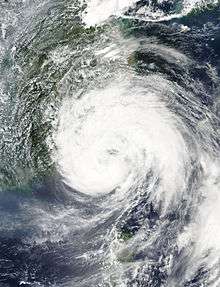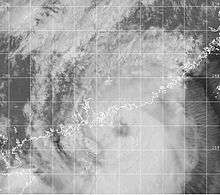China tropical cyclone rainfall climatology

China is a mountainous country, which leads to rapid dissipation of cyclones that move inland as well as significant amounts of rain from those dissipating cyclones. Typhoon Nina in 1975 caused the collapse of two huge reservoirs and ten smaller dams when 1062 mm (41.81 inches) of rain fell in Henan Province during a 24‑hour period. Super Typhoon Carla was the wettest tropical cyclone on record for mainland China. Since 1957, there has been a downward trend in tropical cyclone rainfall for the country.
Mainland
Most of the rain China experiences during the year occurs during the summer months. Typhoons cause many of the intense rains seen within the country. The heavy rains occur over a large area, typically 1,000,000 square kilometres (390,000 sq mi).[1] Across China between the years of 1983 and 2006, an average of 2.9 tropical cyclones move into Guangdong province, making it the most affected province within mainland China. Hainan averages 1.3 tropical cyclones annually, while Fujian experiences 1.2 tropical cyclones annually, and Zhejiang witnessed 0.9 tropical cyclones annually. The wettest tropical cyclone on record for the mainland was Super Typhoon Carla, which dropped 2,749 millimetres (108.2 in) of rain over a 48-hour period. Typhoon Nina (1975) produced the highest areal average rainfall amounts between August 4 and August 8 for the Hongru river basin for most time durations.[1] The risk of tropical cyclones across Guangxi, Jiangsu, Shandong, and Liaoning provinces is significantly lower, with these provinces averaging between 0.1 and 0.4 tropical cyclones annually.[2]

| Precipitation | Storm | Location | Ref. | ||
|---|---|---|---|---|---|
| Rank | mm | in | |||
| 1 | 2749.0 | 108.21 | Carla 1967 | Hsin-Liao | [3] |
| 2 | 1248.0 | 49.13 | Gloria 1963 | Paishih | [3] |
| 3 | 1062.0 | 41.81 | Nina 1975 | ||
| 4 | 831.1 | 32.72 | Fitow 2001 | [4] | |
| 5 | 806.0 | 31.73 | Soudelor 2015 | Wenzhou | [5] |
| 6 | 703.5 | 27.70 | Rananim 2004 | [6] | |
| 7 | >600.0 | >24.00 | Haikui 2012 | Annui Province | [7] |
| 8 | 555.0 | 21.85 | Chanchu 2006 | [8] | |
| 9 | >400.0 | >15.74 | Saola 2012 | [9] | |
| 10 | 360.6 | 14.20 | Bilis 2006 | Guangdong | [10] |
Hong Kong
Typhoon Sam of the 1999 Pacific typhoon season became the wettest known tropical cyclone to impact Hong Kong since records began in 1884, breaking a 73‑year‑old record. A total of 23.98 inches/609 mm of rainfall fell between August 22 and August 25.[11]

| Precipitation | Storm | Location | Ref. | ||
|---|---|---|---|---|---|
| Rank | mm | in | |||
| 1 | 616.5 | 24.27 | Sam 1999 | Hong Kong Observatory | [12] |
| 2 | 597.0 | 23.50 | July 1926 Typhoon | Royal Observatory, Hong Kong | [12] |
| 3 | 562.0 | 22.13 | June 1916 Typhoon | Royal Observatory, Hong Kong | [12] |
| 4 | 530.7 | 20.89 | Agnes 1965 | Royal Observatory, Hong Kong | [12] |
| 5 | 519.0 | 20.43 | Agnes 1978 | Royal Observatory, Hong Kong | [12] |
| 6 | 516.1 | 20.32 | Ellen 1976 | Royal Observatory, Hong Kong | [12] |
| 7 | 497.5 | 19.59 | Dot 1993 | Royal Observatory, Hong Kong | [12] |
| 8 | 491.7 | 19.36 | Dot 1982 | Royal Observatory, Hong Kong | [12] |
| 9 | 480.9 | 18.93 | Helen 1995 | Royal Observatory, Hong Kong | [12] |
| 10 | 473.2 | 18.63 | August 1904 Typhoon | Royal Observatory, Hong Kong | [12] |
Lantau Island
| Precipitation | Storm | Location | Ref. | ||
|---|---|---|---|---|---|
| Rank | mm | in | |||
| 1 | 700 | 27.56 | Ira 1993 | [13] | |
Taiwan/Taipei
The mountainous island of Taiwan province experiences an average of 1.8 tropical cyclone landfalls each year.[2] Due to its rugged topography, Taiwan sees extreme rains from tropical cyclones, particularly in its central mountain range.

| Precipitation | Storm | Location | Ref. | ||
|---|---|---|---|---|---|
| Rank | mm | in | |||
| 1 | 3,060 | 120.47 | Morakot 2009 | Alishan, Chiayi | [14] |
| 2 | 2,319 | 91.30 | Nari 2001 | Wulai, New Taipei | [15] |
| 3 | 2,162 | 85.12 | Flossie 1969 | Beitou, Taipei | [14] |
| 4 | 1,987 | 78.23 | Herb 1996 | Alishan, Chiayi | [16] |
| 5 | 1,774 | 69.84 | Saola 2012 | Yilan City | [17] |
| 6 | 1,700 | 66.93 | Lynn 1987 | Taipei | [18] |
| 7 | 1,672 | 65.83 | Clara 1967 | Dongshan, Yilan | [19] |
| 8 | 1,611 | 63.43 | Sinlaku 2008 | Heping, Taichung | [20] |
| 9 | 1,561 | 61.46 | Haitang 2005 | Sandimen, Pingtung | [21] |
| 10 | 1,546 | 60.87 | Aere 2004 | Miaoli County | [22] |
Tibet Autonomous Region
An early October 2004 tropical depression brought moisture into the highlands of Tibet, leading to daily precipitation of 60 mm/2.4 inches liquid equivalent to Che-Ku County all in the form of heavy snow, which was a new October daily precipitation record for both rain and snow. This led to a loss of 340,000 kg of food, 230,000 kg of forage grass, and 263 livestock in the snowstorm.[23]
See also
- List of wettest tropical cyclones by country
- Tropical cyclone
- Tropical cyclone rainfall climatology
- Tropical cyclone rainfall forecasting
References
- 1 2 Pukh Raj Rakhecha; Vijay P. Singh (2009). Applied Hydrometeorology. Springer. p. 187. ISBN 978-1-4020-9843-7. Retrieved 2011-03-06.
- 1 2 Qiang Zhang; Liguang Wu; Qiufeng Liu (April 2009). "Tropical Cyclone Damages in China: 1983-2006". Bulletin of the American Meteorological Society. American Meteorological Society. 90 (4): 490. Bibcode:2009BAMS...90..489Z. doi:10.1175/2008BAMS2631.1.
- 1 2 J. L. H. Paulhaus (1973). World Meteorological Organization Operational Hydrology Report No. 1: Manual For Estimation of Probable Maximum Precipitation. World Meteorological Organization. p. 178.
- ↑ Padgett, Gary (2006-12-27). "Monthly Global Tropical Cyclone Summary August 2001". Australian Severe Weather Index. Jimmy Deguara. Retrieved 2007-01-13.
- ↑ "重要天气新闻通稿: 今年第13号 台风"苏迪罗"深入内陆影响结束" (in Chinese). National Meteorological Center. August 11, 2015. Archived from the original on August 11, 2015. Retrieved August 11, 2015.
- ↑ Padgett, Gary; Kevin Boyle; John Wallace; Huang Chunliang; Simon Clarke (2005-05-17). "Monthly Global Tropical Cyclone Summary August 2004". Australian Severe Weather Index. Jimmy Deguara. Retrieved 2007-01-13.
- ↑ "China: Floods — Information Bulletin no 2". International Federation of Red Cross and Red Crescent Societies. ReliefWeb. August 10, 2012. Retrieved August 10, 2012.
- ↑ AIRcurrents. "AIR Post-Disaster Survey for Typhoon Chanchu Documents the Vulnerability of the Chinese Building Stock to Wind and Flood". Retrieved 2007-02-25.
- ↑ "China: 13 killed, three missing after heavy rains". Xinhua General News. Zee News. August 7, 2012. Retrieved August 7, 2012.
- ↑ "Bilis brings heavy rains to Fujian, Guangdong, and other places". China Meteorological Administration. 2006-07-15.
- ↑ Gary Padgett. MONTHLY GLOBAL TROPICAL CYCLONE SUMMARY: SEPTEMBER, 1999. Retrieved on 2007-02-19.
- 1 2 3 4 5 6 7 8 9 10 Tropical Cyclones in 2010 (PDF) (Report). Hong Kong Observatory. p. 98. Retrieved 2012-05-14.
- ↑ C. M. Tam and C. M. Cheng. A late-season tropical cyclone related rainstorm in Hong Kong. Retrieved on 2008-03-09.
- 1 2 Central Weather Bureau (2010). "侵台颱風資料庫". Retrieved October 19, 2011.
- ↑ Unattributed (September 9, 2009). "莫拉克颱風暴雨量及洪流量分析" (PDF). Water Resources Agency, Ministry of Economic Affairs, Republic of China. Retrieved July 17, 2011.
- ↑ Unattributed (September 9, 2009). "莫拉克颱風暴雨量及洪流量分析" (PDF). Water Resources Agency, Ministry of Economic Affairs, Republic of China. Retrieved July 17, 2011.
- ↑ Chen Zhi (August 2, 2012). "Typhoon Saola dumps heavy downpours around Taiwan". Xinhua General News. Retrieved August 2, 2012.
- ↑ Joint Typhoon Warning Center; Naval Pacific Meteorology and Oceanography Center (1988). Annual Tropical Cyclone Report: 1987 (PDF) (Report). United States Navy, United States Air Force. Retrieved July 1, 2014.
- ↑ Lianshou, Chen. Topic 2.1 Observing and forecasting rainfall. Fifth International Workshop on Tropical Cyclones. Retrieved August 4, 2012.
- ↑ "Typhoon Sinlaku Central emergency operation center No.12" (PDF). Central emergency operation center. September 16, 2008. Retrieved January 13, 2009.
- ↑ Chiu Yu-Tzu (July 20, 2005). "Haitang fizzles out, leaves Taiwan wet". Taipei Times. Retrieved April 11, 2010.
- ↑ Padgett, Gary. "Monthly Global Tropical Cyclone Summary: November 2004". Retrieved June 10, 2012.
- ↑ Padgett, Gary; Kevin Boyle; John Wallace; Huang Chunliang; Simon Clarke (17 May 2005). "Monthly Global Tropical Cyclone Summary October 2004". Australian Severe Weather Index. Jimmy Deguara. Retrieved 13 January 2007.
